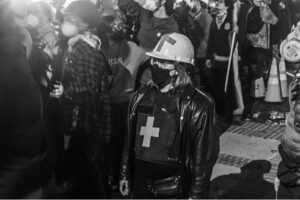 In this time of genocide there is resistance. Not only in Gaza and the West Bank, whose people have never stopped fighting for their liberation, but across the world. From Germany to Mexico the cry of “free Palestine” echoes in defiance of those bent on conquest, vengeance, and atrocity. In the United States, where a seemingly endless supply of money is pumped into the malevolent heart of the Israeli death machine, the vanguard of defiance is the young.
In this time of genocide there is resistance. Not only in Gaza and the West Bank, whose people have never stopped fighting for their liberation, but across the world. From Germany to Mexico the cry of “free Palestine” echoes in defiance of those bent on conquest, vengeance, and atrocity. In the United States, where a seemingly endless supply of money is pumped into the malevolent heart of the Israeli death machine, the vanguard of defiance is the young.
For months there have been marches, petitions, lobbying, and direct actions. This spring saw the tents go up and the barricades erected. The encampments on U.S. campuses represent a strong rebuke of horrors being perpetrated on the other side of the world and the apathy and widespread institutional complicity that enables it. Militant, well-organized, and righteous, this movement pulsates with booming demands: disclosure of institutional investments, divestment from those aiding in the slaughter, and ceasefire.
Disclose, divest, ceasefire now.
Across the encampments the students and their supporters have been maligned, mocked, and subjected to the violence of both the state and Zionist hoodlums. Their movement persists, unwilling, unable to fade away as those in Gaza face the onslaught. The iron ties of solidarity are unbroken. To understand this movement and moment we must go back. Not to October 7, where the ignorant or malevolent want you to believe this began, but to the true historical roots of the conflict. Those lie deep in Herzl’s idea of disappearing the native Palestinian population, Balfour, the Nakba, the Naksa, and Israel’s uplifting of Hamas. More recently the occupation, expanding illegal settlements, the transformation of Gaza into an “open-air concentration camp,” and the violent suppression of mostly peaceful attempts at change like the Great March of Return all contributed to creating the current genocide.
The student movement knows this, and they will not abide it. They stand in a proud tradition of activism perhaps best compared to the struggle against South African apartheid. A critical piece of that effort was the demand that various entities divest from the apartheid regime. The current pro-Palestinian Boycott, Divestment, Sanctions movement has sought to emulate this enormous success despite ferocious pushback that includes statewide bans or penalties in over three dozen states.
It was at Columbia University in New York City that the first encampment sprouted up. Proclaiming themselves in solidarity with Gaza and joining in with the existing voices calling for divestment the students demanded a ceasefire and an end to the university’s financial complicity. This came soon after university presidents like former Harvard leader Claudine Gay were being hauled before bad-faith Congressional hearings and humiliated before finding themselves out of a job. The students’ first attempt at an encampment was torn down by a large number of police who had been called to the campus for the first time since 1968. Days later Columbia president Minouche Shafik was being grilled before Congress. Questions included one from Georgia representative Rick Allen who asked if she wanted “Columbia to be cursed by God.” She demurely replied that she did not. It was during this buffoonery that Columbia students rebuilt. CNN revealed that the students tried to negotiate with the university in good faith, even offering concessions, but the powers-that-be would have none of it. A bombshell report from The Washington Post shows billionaires exerted extraordinary pressure on New York mayor Eric Adams, Shafik, and Columbia’s Board of Trustees to end the encampment. Student negotiators ended talks after what they claim were threats of the National Guard being called in.
Counter-protesters were constantly gathering outside the university’s gates. The mainstream media, having largely fired, reassigned, silenced, or suppressed reporters who showed any concern for Palestinians, pumped out hyped-up stories of protester antisemitism. Strange, given that Jews were an integral part of the encampment and even held a seder there.
After negotiations broke down student leaders were suspended. In some cases they were given mere minutes to pack up their belongings and leave. The day after these sentences were handed down a group of demonstrators took over and occupied Hamilton Hall—which they renamed Hind’s Hall (in memory of Hind Rajab, a six-year-old Palestinian girl killed by Israeli tanks)—recalling actions taken by both anti–Vietnam War and anti-Apartheid activists. The NYPD moved in with force, sending in armed officers with one even “accidentally” discharging his weapon. While a few mistakes were made by the Columbia students, the response was horrifying. The encampment was cleared with all the brutality one has come to expect from American police. Protesters were hit, thrown down stairs, and the cops took down the Palestinian flag in a manner reminiscent of a conquering army.
By the time the encampment was torn down the fires of resistance had already spread across the globe: the National Autonomous University of Mexico, Berlin Free University, Britain’s Cambridge, the University of Tokyo, and U.S. campuses from Georgia to Oregon. Everywhere the students stood up, and in many places they faced what all those who fight for justice face, the iron boot of the state. In Missouri an older professor was slammed to the ground, breaking several of his bones. The University of Texas saw a crackdown so harsh even local camera crews were assaulted by the authorities. At Atlanta’s Emory University the police raked students with pepper balls. One young Black woman was held down by large white officers and Tazed. Representative Mike Collins (R, GA) tweeted, “Not sure what y’all are doing up North, but we don’t give them the time to encamp. Tazers set to stun!” He was not the only national figure to call for aggression against protesters. Echoing his 2020 calls for a violent crackdown on Black Lives Matter, Senator Tom Cotton (R, AR) implied drivers stuck behind demonstrators blocking traffic should meet them with violence. Senate candidate Steve Garvey referred to demonstrators as “terrorists.” Echoing now suspended Israeli heritage minister Amichai Eliyahu, Representative Tim Walberg (R, MI) suggested the Israelis should use nuclear weapons on Gaza.
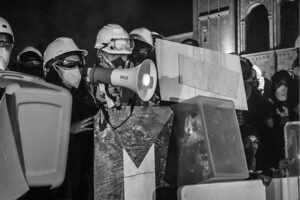
It was into this milieu that I stepped toward the encampments. A friend in Los Angeles leftist circles asked me to look into the mendacity of Pomona College after they sicced the police on a nonviolent student sit-in. The lies and shady practices of campus figures there are something I will be detailing in another article. Pomona’s encampment was situated atop a small mound near the corner of campus. During my interviews, I found many dedicated students with the same demands as those at Columbia. Like their comrades in New York, disclosure, divestment, and a ceasefire were at the top of the list. Often local demands also became incorporated. Columbia students, for example, wanted the university to remediate gentrification in Harlem. In the Los Angeles area student protesters are demanding that universities cut ties with the police.
An often-spat piece of slander is that students and those in solidarity with them are ignorant, unable to even name the “sea” and “river” from the famed protest chant. This is not what I found. Many in the encampments spoke to me on condition of anonymity. This is partly because they very wisely distrust a media that has treated them contemptuously. It’s also based on a well-founded fear of doxxing. In the fall many Zionist groups acquired trucks with video screens to drive around campuses displaying the names of pro-Palestine students and accusing them of antisemitism. At a February College Council meeting for the Claremont Colleges, of which Pomona College is a member, minutes show one student said “I’ve done some stuff I’m not proud of. I am responsible by proxy for doxxing students. I was deceived by the Hillel director. There have been 5C [five colleges] alumni taking pictures of 5C students at SJP rallies to be doxxed. There was a video and I was asked to identify the people in it.”
One Jewish encampment representative I spoke with related their experience traveling to the West Bank, and the profound impact of witnessing the situation there. In discussing the long history of Jews in the region and October 7th I was told something I think will stick with me for the rest of my life: one atrocity does not justify another.
When I went to the University of Southern California, the situation was surprisingly calm. The campus had just been through a jarring series of events. The recently named Valedictorian, Asna Tabassum, had her speech canceled when pro-Israel students dug through her social media and found she had reposted a slideshow that called for the abolition of Israel and for a decolonized state with rights for both Arabs and Jews. The campus claimed the cancellation was done in the name of security. In the wake of this, the newly formed USC student encampment was raided by police in a very public and violent manner.
No one was supposed to be allowed on the USC campus, but I managed to find my way past an indifferent guard to reach a courtyard where students and their supporters were sitting on the grass, listening to speeches, and holding signs. It was sunny; uninvolved students calmly walked by or posed in their gowns for photos in anticipation of the upcoming graduation. You’d hardly think this had been the scene of a violent police crackdown.
“There’s definitely a real desire of universities to quash any activism in general that doesn’t align with their interests, and especially pro-Palestinian activism. USC has shown they’re not hesitant to escalate and call LAPD riot police on their students,” said a Jewish representative of the encampment who works with JVP. “The values that underscore our demands are disclose, defend, and divest.”
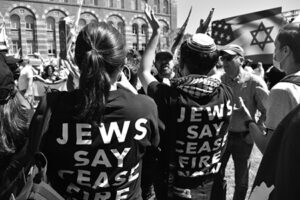
Later, I saw Mark Rayant and his friend Nathan Maryamian standing right next to the protest. Maryamian was wearing a kippah with the symbol of the Israeli Defense Forces on it. The demonstrators were placidly ignoring them. I had heard many claims that Jewish students were deathly afraid of these protests and made to feel threatened. Yet, here were young men right at the source of that supposed fear with one wearing the symbol of the military they know these protesters oppose, and they were safe and sound.
My conversation with them was a strange one. I heard arguments that would be repeated by the Zionists I would meet over the coming days. They questioned the well-established number of Palestinian casualties while claiming it wasn’t about numbers. They said people had made statements like “gas the Jews,” something I never heard or saw. Rayant said he had been in fights over his identity. When I asked the Jewish representative of the encampment if this rang true she told me it didn’t match her experiences.
Rayant told me of his time in Israel working with Palestinian friends to make prosthetics for both of their people. He told me he had protested Netanyahu’s judicial reforms and that he was heartbroken over the death he was witnessing. Still he always absolved Israel of any blame. He seemed far more concerned with the state’s reputation than with the lives of the people it was killing, for which he placed all blame on Hamas. He called Tabassum “divisive,” and called her repost hateful in spite of its regard for Jewish rights. He claimed calls for Israel’s destruction were a threat to him, a statement that would be repeated again and again in criticisms of chants like “from the river to the sea,” and “intifada” when to my eyes these are a call for a restoration of Palestinian rights and a civil uprising. Violent resistance, with proper regard for civilian life, I remind you, is permitted under international law. Rayant showed me something that day: the bankruptcy of Liberal Zionism. At its core it’s linked with the reactionaries in their defense of the status quo, and their valuing of the state over the lives of the innocent.
The center of Los Angeles organizing had fast become UCLA, my old school. The encampment was between Powell Library and Royce Hall. When I first walked around, the signs hung on the barricades expressed solidarity from Filipino, Polish, Mexican, Chinese, and Transgender people. I met many kind and considerate people there. In the days to come I interviewed a representative. He told me their focus was on stopping genocide. He emphasized the goals of divestment and disclosure, and had no regard for UCLA president Gene Block’s claim that it was not in his control.
“When you see a movement like this, such a human movement, it’s impossible not to be inspired,” he told me. “Disruption is power. You have to change the status quo to change what you need to change.”
He said they were cognizant that the protests were having an impact. “We will not stop until the school divests its money from profiting from genocide.”
One student I met made clear that even in a one-state solution they wanted Jews and Palestinians to have equal rights. Another young man there told me he had lost dozens of family members in Gaza. He said only two remained alive. People spoke proudly of videos showing Palestinian children thanking the demonstrators, glad those in Gaza knew they weren’t forgotten. The mood that first night was defiant but peaceful. Those of us who were there will always recall the chant: “Peaceful protest, peaceful protest.” This would be shouted even when the cops came and ended the encampment.
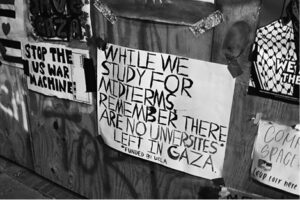
Unfortunately, agitators soon showed up, and the situation deteriorated.
The counter-protesters were aggressive from the start. Dean Golan Cohen, a student from a neighboring college, would go on a disgracefully inaccurate episode of Dr. Phil to claim he had been persecuted and made to fear the encampment despite a video posted online showing him aggressively challenging protesters to fight. This kind of aggression was not unusual. Nouri Mehdizadeh, who would later be spotted attacking the encampment with his brother, Matin, violently shoved a woman into a tent and walked up to her as if to punch her after she yanked his sign out of his hands. When I tried to speak with him and a group of his buddies one night in an effort to try and calm down the tense atmosphere, I was called a faggot—an especially offensive slur given my bisexual identity. Some pro-Israel folks claimed this behavior was provoked by slurs from pro-Palestine protesters, which I never heard or saw. None of their fellow Zionists ever reproached them for this behavior. I constantly heard disgusting things from them. One called a woman in a hijab a whore and said she should go stand on a street corner known for its sex workers. He told one protester he was only here “because Trump’s not in office.” After hours of this, one protester did throw an inappropriate insult back at him, for which he was immediately reproached by another pro-Palestine demonstrator. One night a bag of rats was released near the encampment. Cars parked, put on their high beams, and blared their horns to keep demonstrators from sleeping. They came for conflict from day one.
Zionist counter-demonstrators constantly challenged the pro-Palestine demonstrators to fights. Pro-boxer David Kaminsky did so while spitting and shouting the n-word at a large counter-protest where Israeli-American Council CEO and former Trump administration official Elan Carr spoke of taking back the nation’s campuses. This demonstration’s financiers included Jerry Seinfeld’s wife, Jessica, wealthy local Zionists, and powerful pro-Israel groups like the ADL. Scuffles occurred, and all kinds of hurtful insults flew. The pro-Israel crowd waved bananas at demonstrators to mock one pro-Palestine protester’s food allergy. Death and rape were wished on those standing in solidarity with the Palestinians.
It was at this action that I met a young woman who gave her name as Billy Salmon. She was proudly waving her Syrian Opposition flag. She said the encampments are a mighty tool in the struggle for Palestinian freedom, and that there’s a big connection between their fight and that of Syrians against Assad.
“I have a free Syria flag because my family is Syrian, and we’ve supported Palestine and the freedom of Palestine since the nineties,” she said.
Over the various nights I became increasingly alarmed that violence was becoming more likely. I tried to have rational conversations with some on the pro-Israel side, seeking de-escalation. To my anger and dismay, some of these same people would end up resorting to violence a few nights later. One conversation sticks out in my mind. A young man wearing an IDF flag as a cape was disturbingly blunt. He told me the price of Israeli security was the denial of Palestinian freedom.
Before it even went this far the hypocrisy and bigotry of the Zionists was obvious. Counter-protesters would claim to feel deeply afraid of the demonstrators yet push into them and get right in their faces. One woman, who cravenly declined to put her name to her hatred, shouted “Where’s Palestine?” to imply it does not exist as a nation or people. When I interviewed her, she claimed the West Bank was “Judea and Samaria” and implied it fully belonged to Israel. Statements and signs like this were not uncommon. It strikes me that this is part and parcel of genocide, to deny a group’s existence.
The media coverage was abysmal. Bad actors falsely claimed they were prevented from going into the library or classes because they were Jewish. In fact, the barricades were moved up and cut off the front doors of these buildings in response to constant threats and harassment from agitators. Jewish people were always in the encampment, playing pivotal roles and holding a seder just as at Columbia. Back and side doors were open until the campus shut them down. Any non-supporter or suspected agitator was barred from the encampment, no one because they were Jewish. The campus was wide open and Jews were never banned, and it was always a mere minute or two detour to walk around the encampment. Still, unethical actors made claims of bigotry that flew across gullible news outlets, telegram channels, and social media. Rage grew, hatred was inflamed, and it culminated in the attack.
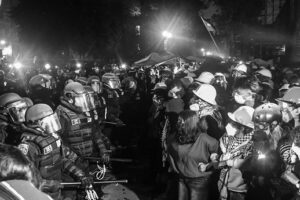
I arrived a few minutes after it started. Demonstrators had already carried a wounded girl away from the center of the mayhem. Enraged counter-protesters, masked up and with melee weapons at the ready, taunted the encampment. I tried to walk among them to document their actions. Lasers and flashing lights were pointed at me, taunts yelled. I could taste violence in the air. I tried to document with my phone, and when I did a firework sailed over my head and into the encampment exploding with a sickening boom. Screams, laughs from the counter-protesters. They were playing the sounds of crying children on a loudspeaker and a song reportedly used to torture Gazan prisoners.
I knew I couldn’t stand by and watch this; we were all in grave danger. I’m a human being first and a reporter second. I soon put my press badge in my pocket, went into the encampment, and quickly hid my camera. I resolved to help the demonstrators protect themselves from the onslaught.
The fireworks knocked out and burned people. One demonstrator had her hand shattered by a hammer. People were beaten with sticks. A local Zionist high school student, Edan On, was seen dancing about in a white purge-style mask and assaulting people, an action his mother would later applaud on Facebook. One man was caught outside the barricades and severely beaten. I watched him walking back to safety in the encampment, head bandaged and blood running down his face. The image is burned into my memory, as are the images of other wounded encampment members laid out on the grass by Royce Hall like a battlefield hospital, most hit with bear spray. Boards and full water bottles sailed over the barricade. A man next to me was hit in the back of the head. I was lucky, though a large traffic cone did hit me in the face. It felt like a hard punch, but I was no worse for wear. Fearing for my life if the barricades were breached, I shoved a piece of scrap metal in my belt, determined not to go down without a fight. Many did the same, though I and seemingly most others did not in the end find need of it.
Despite all of this, the teamwork and courage I saw from the demonstrators was inspiring. Medics, the unsung heroes of that night, helped take the wounded away from the site of combat for treatment. People held up the barricades despite repeated Zionist attempts to rip them down. People passed out food and water as the hours dragged on. When boards were lost to the Zionists, new ones were taken from the scaffolding around Powell to replace them. When large Zionists threatened the flanks, big protesters met them prepared with pipes and sticks in hand. One Zionist grabbed a metal barricade wielding it as if he would throw it into them. He didn’t find the stones to do it. While the Zionists mostly attacked as individuals the demonstrators largely coordinated as a group, plugged holes in the defenses, and listened to calm and precise directions from leadership.
It was this courage, coordination, and care for others that ultimately carried the day. After hours of inaction the police finally moved in and the Zionists retreated. No arrests were made that night.
The Zionists never came through. They didn’t take a damn inch and even the hostile media rightly covered them with mostly contempt in the aftermath. They failed.
The next day the police raided and destroyed the encampment. They couldn’t protect the students and their supporters from a Zionist lynch mob, but they could break up a mostly peaceful protest no problem. It’s just as we say in leftist circles, “we protect us.”
The students held out for hours that night. Barricades reinforced and arms linked, they remained until early morning. At one point a police breach of the back of the encampment was pushed back by a wall of protesters and shields—an amazing sight I had never before seen. A non-lethal gun was pointed right at me from point blank range. As flashbangs exploded overhead the police fired potentially deadly rubber bullets into the crowd. Near the end, one officer took the large Palestinian flag in the middle of the encampment and threw it to the ground. Around 200 would go on to be arrested that night. When it was over and many of those remaining were pushed out the back, one demonstrator got on a bullhorn and the chants started.
“It’s not over.”
“It’s not over.”
And it is not. Currently successful efforts are underway to identify and hold Zionist attackers accountable. Protests continue despite more police repression exemplified by a mass arrest of demonstrators and clearly marked journalists in a parking garage. Recently, another attempt to rebuild the encampment resulted in one young woman being pulled screaming into a police line just for chanting into a bullhorn. While there has been the occasional misstep or misbehavior from those demonstrating for Palestinian freedom here, it has been far outdone by the violence of the police and pro-Israel goons. Encampments remain in place on other campuses. UCLA’s students will continue the struggle even if by other means.
For the genocide continues as Israel attacks Rafah and their destructive yet incompetent army is bogged down by resistance in previously “cleared” areas. The people of Gaza, though suffering, have not been pushed from the land. The students and their supporters see this, and will not stop until these unconquerable people, children of the land, its cities and villages, its deserts and waters and olive trees, are safe and enjoy a just freedom in their homeland. From the Jordan to the Mediterranean. From the river to the sea.


good on you to have engaged in conversations with the zionists at UCLA.. very interesting to read that “the price of Israeli security (is) the denial of Palestinian freedom.”
basically they admit that the only way they can maintain their way of life is by denying another of their way, which is really no way to live, and ergo unsustainable.
anyways, well written, keep up the good work